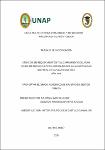Atención de requerimientos y el cumplimiento del plan diario de recojo de residuos sólidos de la Municipalidad Distrital de San Juan Bautista año 2024

Date
2025Author
Garces Nuñez, Marcela
Guerreiro Macedo, Segundo Ramón
Metadata
Show full item recordAbstract
The handling of service requests is key to meeting institutional objectives and ensuring an efficient solid waste collection service through agile communication. This quantitative, descriptive-correlational, non-experimental, cross-sectional study conducted a census survey of 60 employees from the Solid Waste Management Office of the San Juan Bautista District Municipality; the questionnaire achieved an excellent Cronbach’s alpha of 0.917. Descriptive statistics showed that 75 % rated request handling as good (22 % fair, 3 % poor) and 82 % rated waste collection as good (17 % fair, 2 % poor). The Pearson’s r coefficient was 0.0189 (p = 0.148), indicating no significant relationship and supporting H₀. It is inferred that operations function normally with tolerable delays and that the main challenge is improving human resources. Additionally, incorporating real-time tracking and reporting technologies could reduce response times and enhance transparency, and fostering inter-institutional coordination is essential to optimize resources and ensure service continuity. La atención de requerimientos es clave para cumplir objetivos institucionales y asegurar un servicio eficiente de recojo de residuos sólidos mediante comunicación ágil. Este estudio, cuantitativo descriptivo-correlacional, no experimental y transversal, encuestó censalmente a 60 trabajadores de la Gerencia de Gestión de Residuos Sólidos de San Juan Bautista; el cuestionario tuvo un Alfa de Cronbach de 0,917. En lo descriptivo, 75 % calificó la atención de requerimientos como buena (22 % regular, 3 % malo) y 82 % valoró el recojo de residuos como bueno (17 % regular, 2 % malo). El r de Pearson fue 0,0189 (p = 0,148), sin relación significativa, aceptándose H₀. Se deduce que la gestión funciona normalmente, con demoras tolerables, y que el principal reto es mejorar el recurso humano. Además, la incorporación de herramientas tecnológicas para el seguimiento y reporte en tiempo real podría reducir los tiempos de respuesta y mejorar la transparencia, y es fundamental fomentar la coordinación interinstitucional para optimizar los recursos y garantizar la continuidad del servicio.

